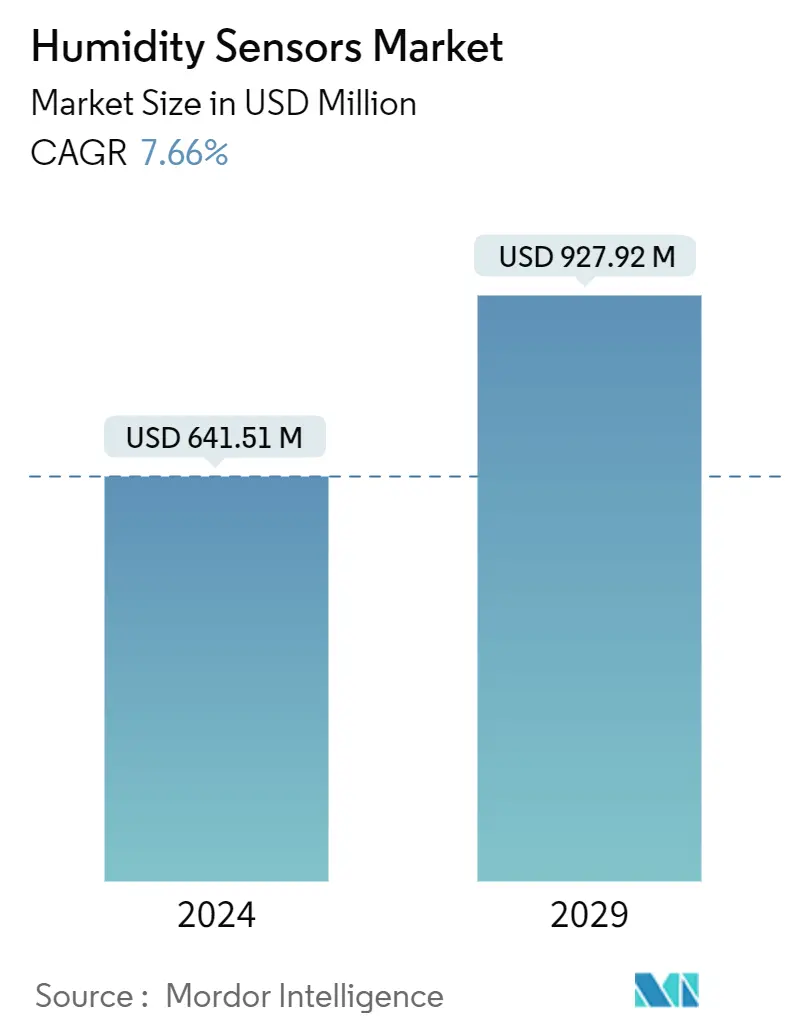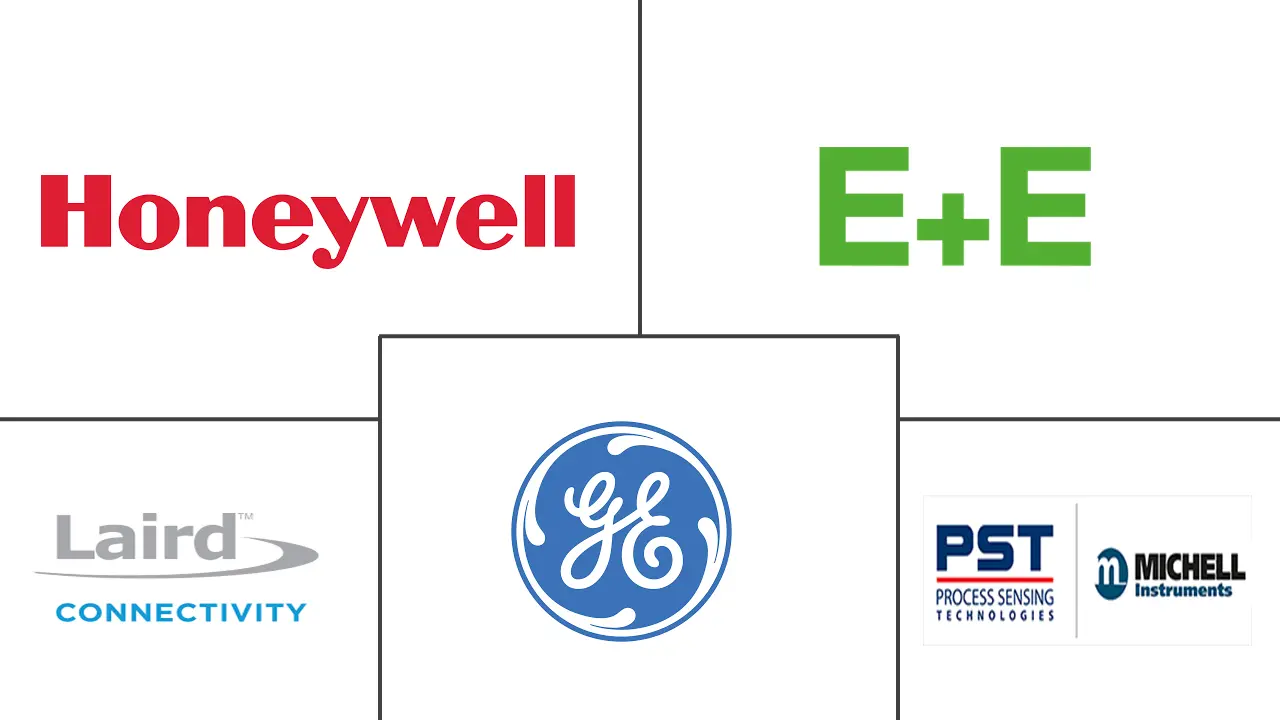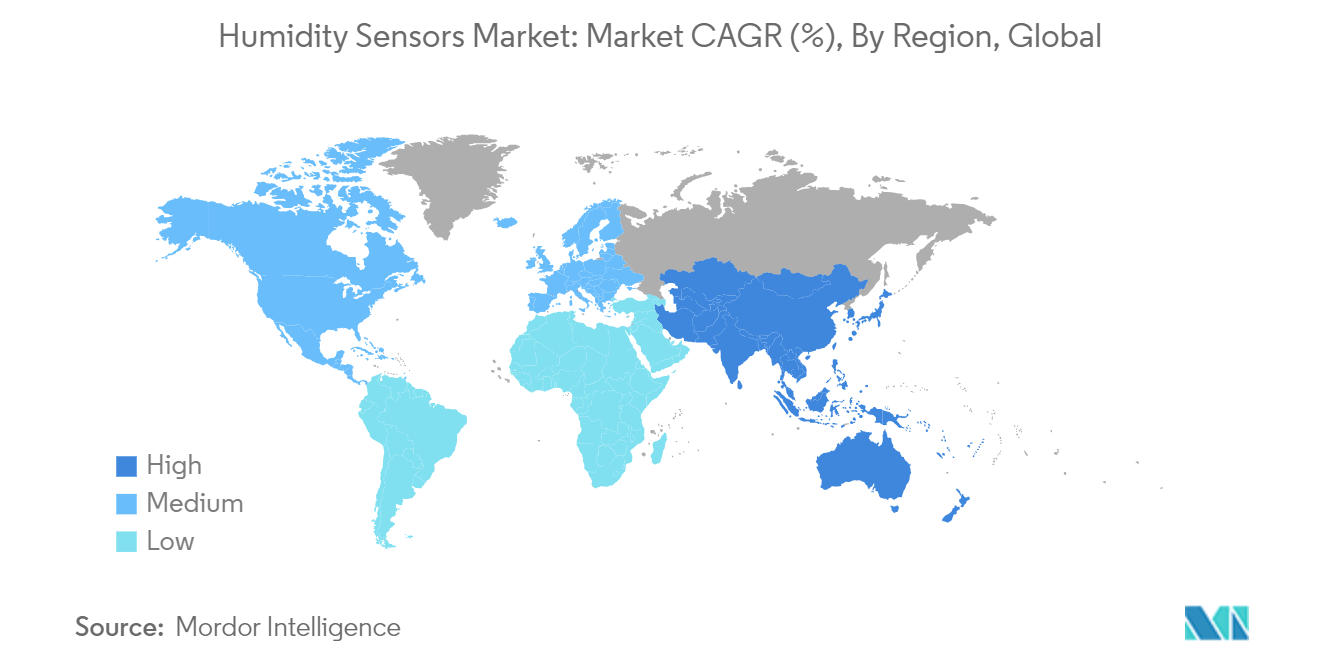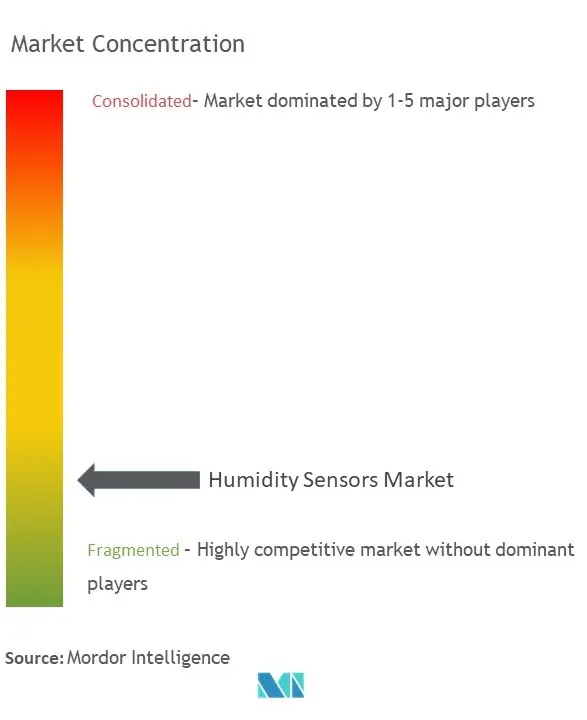Humidity Sensors Market Size

| Study Period | 2019 - 2029 |
| Market Size (2024) | USD 641.51 Million |
| Market Size (2029) | USD 927.92 Million |
| CAGR (2024 - 2029) | 7.66 % |
| Fastest Growing Market | Asia Pacific |
| Largest Market | Asia Pacific |
Major Players
*Disclaimer: Major Players sorted in no particular order |
Humidity Sensors Market Analysis
The Humidity Sensors Market size is estimated at USD 641.51 million in 2024, and is expected to reach USD 927.92 million by 2029, growing at a CAGR of 7.66% during the forecast period (2024-2029).
A humidity sensor is an electronic device that measures the humidity in its environment and converts its findings into a corresponding electrical signal. It comes in various sizes and functions; some are built into handheld devices, while others are part of larger embedded systems (such as air quality monitoring systems). Humidity sensors have wide use in meteorology, medicine, automobiles, HVAC, and industrial production. Some advantages to capacitive sensors include low power consumption, good linearity, and wide-range RH detection, but a complicated fabrication process is a major drawback.
- A humidity sensor’s performance is primarily determined by its nano- and microscopic structure, which includes pore size, layer thickness, size distribution of the surface structural element, surface morphology uniformity, and electrode distance. For implementation, humidity sensors must meet a variety of characteristics, including repeatability, sensitivity, reproducibility, linearity, low hysteresis, fast response-recovery speed, stability, low cost, and ease of connection to control units. Sensors should be designed according to these specifications.
- Humidity sensors can improve performance, reduce energy consumption, and increase safety in a variety of applications. Increasingly, OEMs are designing relative humidity/temperature sensors into engines, electronics, and other products to improve control and output.
- The automotive industry has grown significantly in the past few years, aided by the growth in unit volumes with the emergence of new technologies, whether it be for safety, entertainment, or pure innovation. Government organizations in many countries are implementing safety and emission control standards mandating the installation of sensors. Automotive companies are, thereby, required to comply with the safety and emission control regulations set by these authorities. This trend is expected to increase the demand for automotive temperature sensors over the forecast period.
- However, wireless sensors are vulnerable to various attacks, such as eavesdropping, jamming, and spoofing. They can be susceptible to interference from other wireless devices or radio signals, which can degrade the quality of data transmission. Thus, ensuring the security of the network and the data it collects poses a significant challenge to the market studied. In addition to this, they are typically small and have limited processing and storage capabilities. This makes it challenging to perform complex tasks or store large amounts of data.
- Due to the outbreak of COVID-19, the global supply chain and demand for multiple products have majorly been disrupted, and wireless humidity sensor adoption is anticipated to be influenced until the end of 2020. However, the growing demand for consumer electronics and medical applications significantly increased market growth. Various players were investing and collaborating to cater to the requirements.
Humidity Sensors Market Trends
Automotive Sector to Witness Major Growth
- The automotive sector encompasses a diverse array of companies and entities engaged in creating, advancing, producing, promoting, selling, maintaining, and customizing automobiles. It stands as one of the largest industries globally in terms of revenue, with numerous companies consistently investing in its growth. This industry also presents opportunities for the utilization of humidity sensors used to reduce misting-up of the windows and enhance comfort by managing the humidity levels inside the car.
- The car market grew to approximately 67.2 million vehicles in 2022, compared to 66.7 million in 2021. The industry saw a decline in sales in 2020 and 2021 due to a weakening global economy. The COVID-19 pandemic and Russia's war on Ukraine caused a shortage in automotive semiconductors and supply chain issues in 2022. However, it was expected to resume growth in 2023 and reach 70.8 million units. Similar growth trends are expected to shape the demand for automotive in the future, which further translates to an increase in the market for humidity sensors.
- The automotive sector employs humidity sensors to oversee and manage the climate within vehicles. These sensors play a crucial role in regulating the air conditioning and ventilation system of cars, ensuring that the windows defrost adequately for enhanced safety.
- Moreover, they activate the ventilation process solely when the humidity level surpasses a specific threshold, thereby minimizing power usage and enhancing the overall efficiency of vehicles. As a result, the demand for humidity sensors in the automotive industry continues to expand, fostering market growth. The growing sales of the vehicles and investments in boosting vehicle production are expected to drive the market's potential.

Asia-Pacific is Expected to Dominate the Market
- The humidity sensors market in Asia-Pacific is expected to witness significant growth over the forecast period. Sensors are largely manufactured in the Asia-Pacific region, and sensor technology is widely being used worldwide as cutting-edge technologies rely on the functioning of the sensors.
- The HVAC industry is fueled by infrastructure development, technological advancements, growing tourism activities, advancing disposable income, and government initiatives promoting energy efficiency. The industry is adopting automation, IoT, and AI integration, and the demand for higher-performing and energy-efficient systems is increasing. The region is expected to account for the growth of oil and gas demand. The oil and gas industry often operates in severe onshore and offshore environments under extreme weather conditions. HVAC systems ensure that indoor workspaces remain habitable by maintaining air quality, temperature, and humidity, driving the market growth.
- The 22nd edition of ACREX India, one of the largest exhibitions for air conditioning, heating, ventilation, and intelligent buildings in South Asia, was held in March 2023 at the Bombay Exhibition Centre in Mumbai. The event, organized by the Indian Society of Heating, Refrigerating and Air Conditioning Engineers (ISHRAE) in partnership with Informa Markets, showcased India’s thriving HVAC industry, seeking to contribute to the Prime Minister’s Atmanirbhar vision. The focus would be on technological advancements in the HVAC sector, which are essential for a better future.
- Companies operating in the market focus on innovating new products as part of their business expansion. For instance, in July 2023, Weathernews Inc. and Omron Corporation collaborated and developed a new weather IoT sensor, which was released as Soratena Pro. Soratena Pro is a high-performance weather IoT sensor that monitors elements, including air temperature, humidity, atmospheric pressure, rainfall, wind direction, and wind velocity. Soratena Pro was jointly developed by OMRON, which specializes in sensor development, and Weathernews boasts technology for the highest weather forecast accuracy, leveraging the strengths of both companies.
- The region is also witnessing growth in the food and beverage sectors, with various domestic and international food service outlets entering the region. The use of technology in the food industry is also growing from preparing to consuming food. The food and beverage industry is also a significant user of humidity sensors that monitor the temperature and humidity of food products to prevent any spoilage.
- According to OICA, China took the top position in the production of commercial vehicles in 2022 with 3,184.53 vehicles. Japan and Thailand took second and third positions with 1,269.16 and 1,289.46 production of commercial vehicles, respectively. Moreover, vehicle electrification and hybridization, alliances among automotive players, and rising disposable income stimulate the demand for automotive sensors in the automotive sector. Countries such as China contribute substantially to expanding the global automotive sensors industry. The region is also home to a few large automakers worldwide and is expected to advance its automotive sensors, including the humidity sensors market, over the forecast period.

Humidity Sensors Industry Overview
The humidity sensors market is fragmented. Considering significant advancements in technology, like IIOT and automation, the need for more specific sensors for technology is expected to emerge, which may result in more completive rivalry, and some of the players include General Electric Company, Laird Connectivity, E+E Elektronik GmbH, Honeywell International Inc., and Michell Instrument UK.
In November 2023, E+E Elektronik launched a new generation of accurate and reliable room sensors, CDS201, HTS201, and TES201. Tailored to the respective facility automation application, the company offers a CDS201 3-in-1 device for CO2, humidity, and temperature, the HTS201 humidity and temperature sensor, and the TES201 temperature sensor. Each variant has analog outputs or a digital interface and a large, state-of-the-art display. The functional snap-on enclosure minimizes installation costs and avoids the intake of false air.
In September 2023, Process Sensing Technologies announced the acquisition of Sensore Electronic GmbH. Sensore would be an addition to the existing sensor portfolio. Sensore’s products are particularly well-suited for critical applications in the most demanding industries.
Humidity Sensors Market Leaders
-
General Electric Company
-
Laird Connectivity
-
E+E Elektronik GmbH
-
Honeywell International Inc.
*Disclaimer: Major Players sorted in no particular order

Humidity Sensors Market News
- September 2023: E+E Elektronik launched its most powerful humidity and temperature sensor, the HTS801, for industrial applications on the market. The sensing probes of the HTS801 incorporate a premium, heatable sensing element for accurate measurements, guaranteeing long-term stability even under the most challenging conditions. The HTS801 is particularly well suited to use in applications with high humidity and chemical exposure.
- September 2023: Sensirion and AirTeq announced their partnership for the launch of the indoor air quality monitor AirCheq Pro Series. This collaboration combines the precision and quality of Sensirion's Swiss-made sensors with AirTeq's commitment to delivering exceptional indoor air quality solutions for commercial and residential environments. Sensirion's SHT4x series are highly accurate and reliable humidity and temperature sensors that offer the best price-performance ratio on the market.
Humidity Sensors Market Report - Table of Contents
1. INTRODUCTION
- 1.1 Study Assumptions and Market Definition
- 1.2 Scope of the Study
2. RESEARCH METHODOLOGY
3. EXECUTIVE SUMMARY
4. MARKET INSIGHTS
- 4.1 Market Overview
-
4.2 Industry Attractiveness - Porter's Five Forces Analysis
- 4.2.1 Bargaining Power of Suppliers
- 4.2.2 Bargaining Power of Buyers
- 4.2.3 Threat of New Entrants
- 4.2.4 Threat of Substitutes
- 4.2.5 Intensity of Competitive Rivalry
- 4.3 Impact of COVID-19 Aftereffects and other Macroeconomic Factors on the Market
-
4.4 Major Technology Types Infrared, Bimetallic, Cooled Mirror, and Aluminums Oxide Capacitive, among others
- 4.4.1 Major Technology Types - Infrared
- 4.4.2 Major Technology Types - Bimetallic
- 4.4.3 Major Technology Types - Cooled Mirror
- 4.4.4 Major Technology Types - Aluminum Oxide Capacitive
5. MARKET DYNAMICS
-
5.1 Market Drivers
- 5.1.1 Increasing Demand for Safety in the Process Industries
- 5.1.2 Emerging Applications in the Automotive Industry
-
5.2 Market Restraints
- 5.2.1 Limitations in the Use of Non-contact Technologies
6. MARKET SEGMENTATION
-
6.1 By End-user Industry
- 6.1.1 Chemical and Petrochemical
- 6.1.2 Building Automation (HVAC)
- 6.1.3 Automotive
- 6.1.4 Oil and Gas and Natural Gas
- 6.1.5 Pharmaceutical
- 6.1.6 Semiconductor
- 6.1.7 Power Generation
- 6.1.8 Food and Beverage
- 6.1.9 Paper and Pulp
- 6.1.10 Water, Wastewater, and Incineration
- 6.1.11 Consumer Electronics
- 6.1.12 Other End-user Industries
-
6.2 By Geography
- 6.2.1 North America
- 6.2.2 Europe
- 6.2.3 Asia-Pacific
- 6.2.4 Latin America
- 6.2.5 Middle East and Africa
7. DISTRIBUTION CHANNEL ANALYSIS
8. COMPETITIVE LANDSCAPE
-
8.1 Company Profiles*
- 8.1.1 General Electric Company
- 8.1.2 Laird Connectivity
- 8.1.3 E+E Elektronik GmbH
- 8.1.4 Honeywell International Inc.
- 8.1.5 Mischell Instrument UK
- 8.1.6 TE Connectivity Ltd
- 8.1.7 Sensirion AG
- 8.1.8 Bosch Sensortec GmbH
- 8.1.9 Texas Instruments Incorporated
- 8.1.10 Amphenol Advanced Sensors
- 8.1.11 STMicroelectronics International NV
9. INVESTMENT ANALYSIS
10. MARKET OPPORTUNITIES AND FUTURE TRENDS
** Subject To AvailablityHumidity Sensors Industry Segmentation
A humidity sensor is an electronic device that measures the humidity in its environment and converts its findings into a corresponding electrical signal. Humidity sensors are a part of environmental sensors.
The humidity sensors market is segmented by end-user industry (chemical and petrochemical, building automation (HVAC), automotive, oil and gas and natural gas, pharmaceutical, semiconductor, power generation, food and beverage, paper and pulp, water, wastewater, incineration, consumer electronics, and other end-user industries) and geography (North America, Europe, Asia-Pacific, Latin America, and Middle East & Africa). The market size and forecasts are provided in terms of value (USD) for all the segments mentioned above.
| By End-user Industry | Chemical and Petrochemical |
| Building Automation (HVAC) | |
| Automotive | |
| Oil and Gas and Natural Gas | |
| Pharmaceutical | |
| Semiconductor | |
| Power Generation | |
| Food and Beverage | |
| Paper and Pulp | |
| Water, Wastewater, and Incineration | |
| Consumer Electronics | |
| Other End-user Industries | |
| By Geography | North America |
| Europe | |
| Asia-Pacific | |
| Latin America | |
| Middle East and Africa |
Humidity Sensors Market Research FAQs
How big is the Humidity Sensors Market?
The Humidity Sensors Market size is expected to reach USD 641.51 million in 2024 and grow at a CAGR of 7.66% to reach USD 927.92 million by 2029.
What is the current Humidity Sensors Market size?
In 2024, the Humidity Sensors Market size is expected to reach USD 641.51 million.
Who are the key players in Humidity Sensors Market?
General Electric Company, Laird Connectivity, E+E Elektronik GmbH and Honeywell International Inc. are the major companies operating in the Humidity Sensors Market.
Which is the fastest growing region in Humidity Sensors Market?
Asia Pacific is estimated to grow at the highest CAGR over the forecast period (2024-2029).
Which region has the biggest share in Humidity Sensors Market?
In 2024, the Asia Pacific accounts for the largest market share in Humidity Sensors Market.
What years does this Humidity Sensors Market cover, and what was the market size in 2023?
In 2023, the Humidity Sensors Market size was estimated at USD 592.37 million. The report covers the Humidity Sensors Market historical market size for years: 2019, 2020, 2021, 2022 and 2023. The report also forecasts the Humidity Sensors Market size for years: 2024, 2025, 2026, 2027, 2028 and 2029.
Humidity Sensor Industry Report
Statistics for the 2023 Humidity Sensor market share, size and revenue growth rate, created by Mordor Intelligence™ Industry Reports. Humidity Sensor analysis includes a market forecast outlook to 2029 and historical overview. Get a sample of this industry analysis as a free report PDF download.



